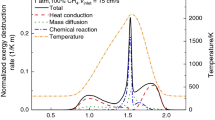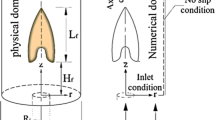Abstract
A numerical study of the counterflow diffusion flames of methane/air at both subcritical and supercritical pressures, which have very important applications in the air-breathing rocket and advanced gas turbine engines, is conducted to obtain fundamental understanding of the flame characteristics. The analysis is based on a general mathematical formulation and accommodates a unified treatment of general fluids thermodynamics and accurate calculations of thermophysical properties. Results reveal that the maximum flame temperature occurs on the fuel-rich side for low-pressure conditions and shifts toward the stoichiometric position when the pressure increases. The maximum flame temperature increases with an increasing pressure, but decreases with an increasing strain rate. The flame width is inversely proportional to the square root of the product of the pressure and strain rate as \({{\delta \propto 1} \mathord{\left/ {\vphantom {{\delta \propto 1} {\sqrt {p \cdot a} }}} \right. \kern-\nulldelimiterspace} {\sqrt {p \cdot a} }}\). The total heat release rate varies with the pressure and strain rate in a relationship of (Q release √(p·a)0.518. An increased pressure leads to a slightly more complete combustion process near the stoichiometric position, but its effect on NO production is minor. Under the test conditions, variations of the strain rate have significant impacts on the formation of major pollutants. An increased strain rate leads to the decreased mole fraction of CO in the fuel-rich region and significantly reduced NO near the stoichiometric position.
Similar content being viewed by others
References
Yang V. Modeling of supercritical vaporization, mixing, and combustion processes in liquid-fueled propulsion systems. P Combust Inst, 2000, 28: 925–942
Singla G, Scouflaire P, Rolon C, et al. Transcritical oxygen/transcritical or supercritical methane combustion. P Combust Inst, 2005, 30: 2921–2928
Habiballah M, Oran M, Grisch F, et al. Experimental studies of high-pressure cryogenic flames on the mascotte facility. Combust Sci Technol, 2006, 178: 101–128
Candel S, Juniper M, Singla G, et al. Structure and dynamics of cryogenic flames at supercritical pressure. Combust Sci Technol, 2006, 178: 161–192
Chehroudi B, Talley D, Coy E. Visual characteristics and initial growth rates of round cryogenic jets at subcritical and supercritical pressures. Phys Fluids, 2002, 14: 850–861
Segal C, Polikhov S A. Subcritical to supercritical mixing. Phys Fluids, 2008, 20: 052101
Yin Y M, Lu X Y. Effects of injection temperature on the jet evolution under supercritical conditions. Chin Sci Bull, 2009, 54: 4197–4204
Heo J Y, Kim K J, Sung H G, et al. Numerical study on kerosene/LOx supercritical mixing characteristics of a Swirl Injector. AIAA 2012-1266, 2012
Kee R J, Miller J A, Evans G H, et al. A computational model of the structure and extinction of strained, opposed flow, premixed methane-air flames. In: the Twenty-second Symposium (International) on Combustion, 1989, 22: 1479–1494
Sung C J, Liu J B, Law C K. Structure response of counterflow diffusion flames to strain rate variations. Combust Flame, 1995, 102: 481–492
Liu S, Hewson J C, Chen J H, et al. Effects of strain rate on high-pressure nonpremixed n-heptane autoignition in counterflow. Combust Flame, 2004, 137: 320–339
Sun W T, Uddi M, Ombrello T, et al. Effects of non-equilibrium plasma discharge on counterflow diffusion flame extinction. P Combust Inst, 2011, 33: 3211–3218
Zhang H Q, Yang F, Wang X L. The effects of soret diffusion on extinction limit in premixed and diffusion counterflow n-butane/air flames. Combust Sci Technol, 2012, 184: 517–532
Ribert G, Zong N, Yang V, et al. Counterflow diffusion flames of general fluids: Oxygen/hydrogen mixtures. Combust Flame, 2008, 154: 319–330
Meng H, Yang V. A unified treatment of general fluid thermodynamics and its application to a preconditioning scheme. J Comput Phys, 2003, 189: 277–304
Meng H, Hsiao G C, Yang V, et al. Transport and dynamics of liquid oxygen droplets in supercritical hydrogen streams. J Fluid Mech, 2005, 527: 115–139
Pons L, Darabiha N, Candel S, et al. Mass transfer and combustion in transcritical non-premixed counterflows. Combust Theor Model, 2009, 13: 57–81
Wang X, Huo H, Yang V. Supercritical combustion of general fluids in laminar counterflows. AIAA 2013-1165, 2013
Kim T, Kim Y, Kim S. Numerical analysis of gaseous hydrogen/liquid oxygen flamelet at supercritical pressures. Int J Hydrogen Energ, 2011, 36: 6303–6316
Peters N. Laminar flamelet concepts in turbulent combustion. P Combust Inst, 1988, 21: 1234–1250
Zong N, Yang V. Near-field flow and flame dynamics of LOX/methane shear-coaxial injector under supercritical conditions. P Combust Inst, 2007, 31: 2309–2317
Cutrone L, De Palma P, Pascazio G, et al. A RANS flamelet-progress-variable method for computing reacting flows of real-gas mixtures. Comput Fluids, 2010, 39: 485–498
Kim T, Kim Y, Kim S. Real-fluid flamelet modeling for gaseous hydrogen/cryogenic liquid oxygen jet flames at supercritical pressure. J Supercrit Fluid, 2011, 58: 254–262
Huo H, Yang V. Supercritical LOX/methane combustion of a shear coaxial injector. AIAA 2011-326, 2011
Reid R C, Prausnitz J M, Poling B E. The Properties of Gases and Liquids. New York: McGraw-Hill, 1987
Yang V, Lin N N, Shuen J S. Vaporization of liquid oxygen (LOX) droplets in supercritical hydrogen environments. Combust Sci Technol, 1994, 97: 247–270
Meng H, Yang V. Clustering effects on liquid oxygen (LOX) droplet vaporization in hydrogen environments at subcritical and supercritical pressures. Int J Hydrogen Energ, 2012, 37: 11815–11823
Meng H, Yang V. Vaporization of two liquid oxygen (LOX) droplets in tandem in convective hydrogen streams at supercritical pressures. Int J Heat Mass Tran, 2014, 68: 500–508
Wang Y Z, Hua Y X, Meng H. Numerical study of supercritical turbulent convective heat transfer of cryogenic-propellant methane. J Thermophys Heat Tran, 2010, 24: 490–500
Wang L, Chen Z, Meng H. Numerical study of conjugate heat transfer of cryogenic methane in rectangular engine cooling channels at supercritical pressures. Appl Therm Eng, 2013, 54: 237–246
Kee R J, Rupley F M, Miller J A. Chemkin III: A FORTRAN chemical kinetics package for the analysis of gas-phase chemical kinetics. Sandia National Laboratories Report SAND96-8216, 1996
Lutz A E, Kee R J, Grcar J F, et al. OPPDIF: A FORTRAN program for computing opposed-flow diffusion flames. Sandia National Laboratories Report SAND96-8243, 1996
Smith G P, Golden D M, Frenklach M, et al. GRI-MEch. http://www.me.berkeley.edu/gri_mech/
Author information
Authors and Affiliations
Corresponding author
Rights and permissions
About this article
Cite this article
Yu, J., Meng, H. A numerical study of counterflow diffusion flames of methane/air at various pressures. Sci. China Technol. Sci. 57, 615–624 (2014). https://doi.org/10.1007/s11431-014-5484-6
Received:
Accepted:
Published:
Issue Date:
DOI: https://doi.org/10.1007/s11431-014-5484-6




